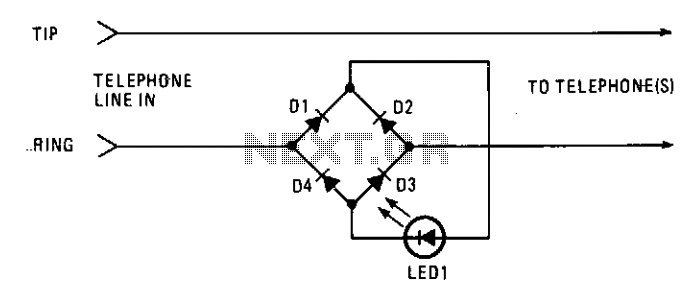
Telephone in-use indicator

This circuit operates as a line-current sensor and can be connected in series with any of the phone lines. To indicate an "in use" status for all phones on a single line, it must be connected in series with the phone line prior to all phones on that line. Additionally, since the power for the circuit is provided by the phone company, an off-hook indicator circuit could be added to each phone.
The line-current sensor circuit is designed to monitor the current flowing through a telephone line, allowing it to detect when the line is in use. The circuit typically includes a current sensing element, such as a shunt resistor or a Hall effect sensor, which generates a voltage proportional to the line current. This voltage is then processed by a comparator or microcontroller to determine the status of the line.
To ensure proper functionality, the circuit must be connected in series with the telephone line. This means that the circuit is placed before all phones on the line, allowing it to sense the current drawn when any phone goes off-hook. When the current exceeds a certain threshold, indicating that a phone is in use, the circuit can activate an indicator, such as an LED or a relay, to signal that the line is occupied.
The power supply for this circuit is derived from the telephone line itself, which typically provides a nominal voltage of around 48 volts DC when idle. This voltage is sufficient to power the circuit without requiring an external power source. The inclusion of an off-hook indicator at each phone can enhance the usability of the system, providing a local visual cue that the line is currently in use.
In summary, this line-current sensor circuit is a practical solution for monitoring telephone line usage and can be effectively implemented in both residential and commercial applications to improve communication management.This circuit functions as a line-current sensor and can be connected in series with either of the phone lines. For the circuit to indicate an "in use" status for all phones on a single line, it must be connected in series with the phone line before, or ahead of all phones on the line.
Since the power for the circuit is supplied by the phone company, a circuit could be added to each phone as an off-hook indicator.
The line-current sensor circuit is designed to monitor the current flowing through a telephone line, allowing it to detect when the line is in use. The circuit typically includes a current sensing element, such as a shunt resistor or a Hall effect sensor, which generates a voltage proportional to the line current. This voltage is then processed by a comparator or microcontroller to determine the status of the line.
To ensure proper functionality, the circuit must be connected in series with the telephone line. This means that the circuit is placed before all phones on the line, allowing it to sense the current drawn when any phone goes off-hook. When the current exceeds a certain threshold, indicating that a phone is in use, the circuit can activate an indicator, such as an LED or a relay, to signal that the line is occupied.
The power supply for this circuit is derived from the telephone line itself, which typically provides a nominal voltage of around 48 volts DC when idle. This voltage is sufficient to power the circuit without requiring an external power source. The inclusion of an off-hook indicator at each phone can enhance the usability of the system, providing a local visual cue that the line is currently in use.
In summary, this line-current sensor circuit is a practical solution for monitoring telephone line usage and can be effectively implemented in both residential and commercial applications to improve communication management.This circuit functions as a line-current sensor and can be connected in series with either of the phone lines. For the circuit to indicate an "in use" status for all phones on a single line, it must be connected in series with the phone line before, or ahead of all phones on the line.
Since the power for the circuit is supplied by the phone company, a circuit could be added to each phone as an off-hook indicator.





